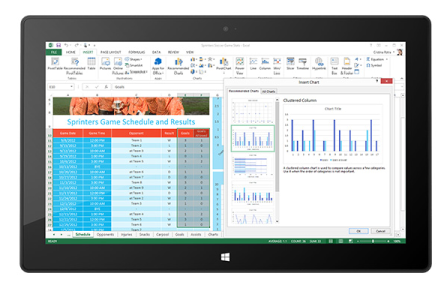What's wrong with tech in US K-12 education today

If you surveyed the different directions K-12 school districts take in the United States, you'd find nothing less than a hodgepodge of technologies. The mess that was known as "Novell Hell" universally bows down to a diverse array of technologies including Active Directory, campus-wide Wi-Fi, iPads, Chromebooks, and a little bit of everything else in between. While it's reassuring that most districts I'm in discussions with are moving to cloud-based Google Apps or Office 365 for their email, the end-user device side of things is murkier.
I'm not going to call myself an expert in K-12 technology and policy, but seeing that I spent the last four years supporting and training users' technology needs at my former high school district, I've got good experience understanding the issues affecting teachers and students alike. After attending educational tech conferences year after year, the common consensus stands: everyone in education knows where they want to be, but the paths some of them take to get there are muddled with too much idealism and not enough realism.
Readers who frequent BetaNews know that I'm very passionate about the topic of educational tech. I've already shared my thoughts on why the Surface and Chromebook are better devices for 1:1 student engagement, and specifically why the Surface has better long terms odds for K-12 over Apple's iPad. But the debate has to go further than merely just devices and "cool-factor". Our public education system ranks a measly #17 of the world's greatest powers, and I think leveraging technology properly is one way we can get back on track and regain our elite ranking that we once held a half century ago.
Problem 1: Many Teachers refuse to realign their Teaching Styles
The move towards 1:1 computing in K-12 education is meaningless if teachers aren't willing to rethink, realign, and downright renovate their entire instructional mentality. Too much of the 1990s and early 2000s was spent wasting oodles of money on pet projects and technology implementations that didn't really further students' overall foundations of technical aptitude in any way. And teachers were then forced under the bus by administration to "adopt or die" even if the path forward was illogical and useless for the overall betterment of the student body.
Much of this issue extends well into today, where my consulting company FireLogic comes across many seasoned teachers who are scared to branch out and utilize new-age technologies like Google Apps or Chromebooks full time. Some of the fears stem from appropriate auxiliary-but-related problems like sporadic Wi-Fi coverage in buildings, but a lot of it is tied to a reluctance to change the "status quo". It's easier to keep on the path forward than to deviate and build something fresh.
While the student body at large has already been moving towards an online-driven and device-enriched culture, the teaching body as a whole is stuck in the textbook and paper mindset. The few technologies that teachers have adopted fairly well (like Microsoft Word and online research) are unchanged from the way they were used starting back in the mid 1990s. So now we have a generational gap where students are truly outpacing their teachers, and many instructors are torn whether to keep up or just give up on tech.
At my former high school district, for example, I spent years trying to educate teachers conceptually and functionally how Google Docs was a much better approach for student created work (Office Web Apps affords similar benefits to Google Docs now, too, through Office 365.) Students could collaborate on teamwork in real time, share notes and spreadsheets to fellow students in a single click, and the fear of losing work was eliminated due to Docs' wonderful cloud auto save functionality. So what was the hangup that kept Docs adoption down? Teachers refused to change the way they graded papers -- with red pen in hand, no less.
There is a lot of technology out there in education that never sees the light of day, with all of its benefits to boot, because we have a generation of teachers who are afraid to leave their comfort zone due to fears, unjustified or not. Some facets of K-12 education have been making the right moves, like adopting 1:1 programs and/or flipping their classrooms, but the progress has not kept up with the general direction of student learning expectations.
Problem 2: Too Much Focus on Consumption
The consumption-first mentality is one of the biggest problems surrounding K-12 "growing up" when it comes to technology adoption for the 21st century. What does consumption-first in K-12 look like? Districts that push 1:1 computing initiatives driven around app-centric devices like the iPad or Android tablets. These hardware choices are not well suited for education in a number of ways, including the lack of traditional input devices like keyboards/mice and too much importance placed on consumption instead of creation.
I'm not here to discourage iPad or Android tablet plans ad hoc. There are situations and areas where these devices make sense. Special Education, for example, benefits greatly from iPads in my own former district and this is something that should be praised. But applying such focused use case scenarios into the macro at large, aka an entire high school student body, is recipe for disaster.
Where do devices like the iPad excel? In consumption oriented tasks, driven by the use of single-purpose apps that are built for limited functionality. Sure, Google Apps offers the Drive app for Docs access, but is this an ideal way for students to access and organize their work on a prime-time scale? Definitely not. The same goes for research, analysis, and information dissertation in a number of other related areas for the modern student. If asking a student to type research papers and collaborate in groups on a touch based tablet is the new norm, then I must be behind the times.

Microsoft Surface could possibly be one of the best post-PC platforms for students and educators alike; if only K-12 was willing to look past the iPad standard that is overtaking many districts.
While there is a place for consumption in K-12 education, we shouldn't fall victim into training the next generation of workers that consumption is more important than all else. Well-made apps that teach a given topic for a subject have their role in the classroom -- but they should not be the driving force guiding device policy, especially in the wake of 1:1 computing pilots. We should ask more of our students, preparing them for the real world that expects ever-more demanding competency in typing, analysis, mathematics, and extensive group work.
The new wave of computing hitting districts nationwide may be moving away from centralized computer labs, but it certainly is not necessitating a shift from keyboard-based input and the flexibility that traditional input devices afford. And I think there are lots of options that provide the flexibility our students need. Chromebooks, Surface tablets, and some other mixed-use hardware is a much better answer to this reality than single-purpose iPads that need dongles and extras just to double as usable input-focused machines.
Problem 3: Adopting Technology that is guided by Fads, not Goals
One good example is the misguided approach many K-5 districts took early on when it came to deciding which computing platform they wanted to unify upon. At least in my neck of the woods, this happened to be Apple, only to present all those graduating into high school and college with the reality check that the real world still runs primarily on Windows PCs. Luckily, my own high school district standardized on Windows machines nearly across the board, but many districts do students an injustice by pushing technologies that are not widespread in the world of work.
A fellow BetaNews reader emailed me with his shared viewpoint on this problem. "The use of Apple based products in schools is something I never could understand. In fact I consider it ridiculous from a cost point of view and a practical benefit as well", Robert Peltier stated in his message. "How many businesses use Apple compared to Microsoft Windows?"
A good question indeed. If operating system usage numbers continue to hold, Windows will still have a solid 90-percent+ of the global computer share. In plain speak, this means more likely than not, students entering the work world will have to deal with Windows-based machines 9 out of 10 times. Perhaps more, as established business generally prefers Windows over OS X at an ever higher rate. So what benefit does a childhood of schooling centered around Apple equipment really provide? If the educational system is here to prepare students for their next steps in life, I'm not sure if this approach makes much sense.
My own former employer and high school district made a similar mistake when jumping on the touch bandwagon without a solid vision as to the why and the how around the initiative. With budget money spilling at the seams, district decided that every classroom would receive one of these ill-conceived QOMO Tablets. At face value, the devices seem to fill the input gap between pen/paper and digital.
But their implementation and execution was flawed in every way from the very start. Like many other failed tech launches in K-12, the devices were merely dumped into classrooms without any proper training or guidance. It was expected that just because the iPad craze was in full swing, everyone would cozy up to touch and incorporate the tablets into day-to-day teaching. Were they wrong.
My own experience found less than 5 percent of our district's teachers even considered the devices; the remaining few who did try them were inundated with a range of issues due to sub-par technology design, leading most of them to drop the tablets altogether from lesson plans. And so the devices sat; pushed into corners, with our technology department expected to "keep supporting them" with no end in sight. They became the laughing stock of tech policy in our district.
I don't think one single party can be blamed on similar failed initiatives. Districts have a spending problem in that they are forced to expunge budget money before they lose it. Educational tech leaders are too often caught up in fads being pushed both by outside influence and a vocal subset of teachers - a sort of "keeping up with the Joneses" mentality in education today.
I think if districts were more often looked at to resolve problems in the way that corporate America does, we wouldn't have the kind of waste on ineffective technologies and short-sighted pilots as we do today. A focus on ROI (return on investment) in the mindset that student education needs to be balanced as much with logical technology platforms as it does with common-sense spending habits.
Let's shift the Debate: How can we BEST prepare the Next Generation?
My background in educational technology has taught me a few things, and one of the most notable ones is that using tech fads as a guide for what's best in a student's hands does no one justice. Budgets are unnecessarily bloated by expensive hardware (Apple gear isn't the only culprit here); K-12 tech leaders believe that new hardware alone will solve all ills; and administration just wants to be able to push out the next self-praising press release to the community and save face.
The messes of yesteryear are finally bearing way to more reasoned approach and a fresh thinking to the way districts can bring tech into students' hands. One of the best moves that could be sweeping K-12 across America, 1:1 Computing, is our best shot at grasping the moment to re-think what students need going forward and how to best equip them for that vision. But let's not make the same mistakes of the past.

Chromebooks save $935 on average over a three-year span, compared to other alternatives like iPad. They are rugged, cost-effective, and excellent options for 1:1 programs. ("Quantifying the Economic Value of Chromebooks for K-12 Education"; IDC, Aug 2012)
Collaboration is definitely one of the keys to this debate. Inclusive platforms like Google Apps and Office 365 are providing students and educators with the means to weave together rich, online-driven instruction without tying everyone to a single brand of hardware or price level. Unlike an iPad and iTunes Store, you can use either Office 365 or Google Apps on a PC or Apple device with a similar experience, give or take some bells/whistles here or there.
But if we are to believe that touch is where computing is headed, Surface is a device that truly invokes the best of both worlds. A platform that shifts from tablet to traditional laptop in a matter of seconds, and offers tactile input along with touch-based capability seamlessly. I really think this is where education wants to be, but just doesn't know how to best get there. The one common theme from teachers who I mingled with at educational tech conferences was that touch on the iPad was great, but the technical boundaries and reliance on Apple's strict iTunes Store for nearly every aspect of functionality were near universal grievances.
And so I ask: why don't we broaden the horizon? Instead of focusing so much energy and attention on the iPad and its Android clones, let's ask ourselves if this family of single-function devices is really what students need to excel and prepare themselves for post-K12 and life in general. Too many college professors at America's finest higher-ed institutions question the preparedness of incoming students year after year. Taking the opportunity that is 1:1 computing and dumbing it down to a generation of iPad-aholics is a sad excuse for technology in the classroom.
So when I learned just a few weeks back that my former high school district is moving to Google Chromebooks for all students, it was a true sigh of relief. There is still some dose of reasoned sanity in the educational sector, it seems. If teachers can integrate the devices to capitalize on their inherent benefits, perhaps we can close that American education gap -- one baby step, and district, at a time.
 Derrick Wlodarz is an IT professional who owns Park Ridge, IL (USA) based computer repair company FireLogic. He has over 7+ years of experience in the private and public technology sectors, holds numerous credentials from CompTIA and Microsoft, and is one of a handful of Google Apps Certified Trainers & Deployment Specialists in the States. He is an active member of CompTIA's Subject Matter Expert Technical Advisory Council that shapes the future of CompTIA examinations across the globe. You can reach out to him at [email protected].
Derrick Wlodarz is an IT professional who owns Park Ridge, IL (USA) based computer repair company FireLogic. He has over 7+ years of experience in the private and public technology sectors, holds numerous credentials from CompTIA and Microsoft, and is one of a handful of Google Apps Certified Trainers & Deployment Specialists in the States. He is an active member of CompTIA's Subject Matter Expert Technical Advisory Council that shapes the future of CompTIA examinations across the globe. You can reach out to him at [email protected].
